Wheat, one of the most important cereal crops, serves as a staple food for millions worldwide. Different wheat varieties, grown in various regions, have unique qualities and applications. In this comprehensive article, we will explore different types of wheat, annual production statistics, and the largest export markets for each variety.
Types of Wheat:
Hard Red Winter (HRW) Wheat
Hard Red Winter wheat is a versatile and widely cultivated variety known for its robust gluten content. It is used primarily for making bread and all-purpose flour.
Soft Red Winter (SRW) Wheat
Soft Red Winter wheat is prized for its lower gluten content and is commonly used for pastry flour and crackers.
Durum Wheat
Durum wheat is known for its high protein content and is used predominantly to make pasta, such as spaghetti and macaroni.
Hard Red Spring (HRS) Wheat
Hard Red Spring wheat is favored for its high gluten and protein content, making it ideal for artisanal bread and pizza dough.
Soft White Wheat
Soft White wheat, with its lower protein content, is suitable for making cakes, pastries, and Asian noodles.
Annual Global Production Levels
Wheat production is a vital aspect of global agriculture. Here are the annual production levels of some major wheat-producing countries:
- China
- Annual Production: Approximately 134 million metric tons
- Leading Export Market: China exports wheat mainly to neighboring Asian countries, including Indonesia and Japan.
- India
- Annual Production: Around 105 million metric tons
- Leading Export Market: India's wheat exports are primarily to neighboring countries like Bangladesh, Nepal, and Sri Lanka.
- Russia
- Annual Production: Roughly 83 million metric tons
- Leading Export Market: Russia is a major exporter of wheat to various countries, including Egypt, Turkey, and Bangladesh.
- United States
- Annual Production: About 52 million metric tons
- Leading Export Market: The United States exports wheat to numerous countries, with Mexico, Japan, and the Philippines being significant markets.
- France
- Annual Production: Approximately 37 million metric tons
- Leading Export Market: France exports wheat to various countries within the European Union and also to North African nations, such as Algeria and Morocco.
Biggest Export Markets for Wheat Categories
Hard Red Winter (HRW) Wheat
- Leading Exporter: United States Biggest Export Markets: Mexico, Japan, and the Philippines
Durum Wheat
- Leading Exporter: Canada
- Biggest Export Markets: Italy, Algeria, and Tunisia
Soft White Wheat
- Leading Exporter: United States
- Biggest Export Markets: Mexico, Japan, and the Philippines

